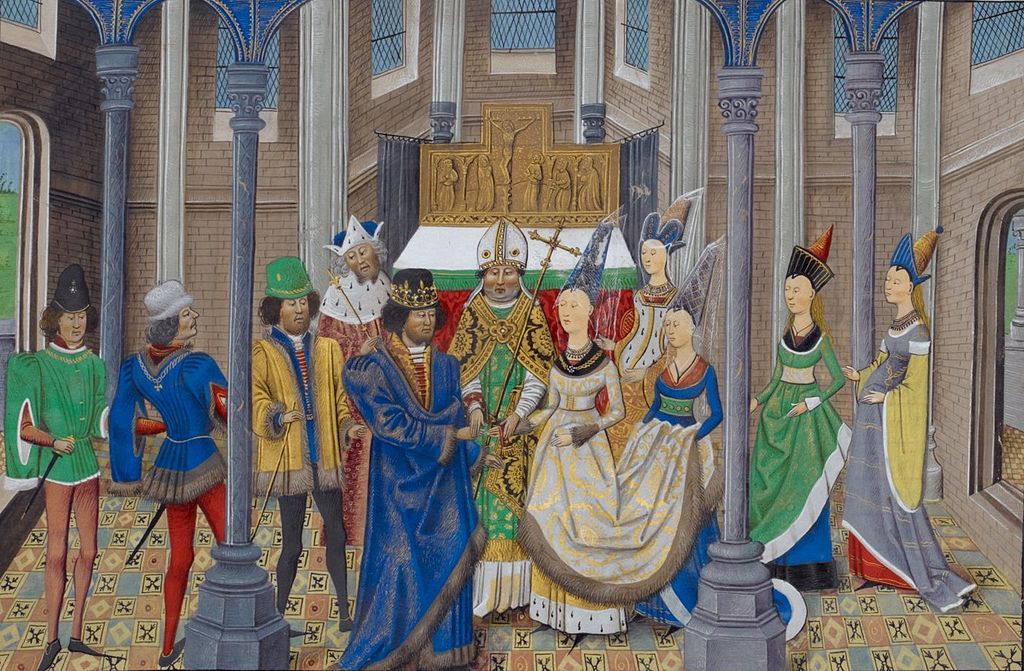by Emily McMahon, revised by Susan Flantzer © Unofficial Royalty 2013

Philippa of Lancaster, Queen of Portugal; Credit – Wikipedia
Philippa of Lancaster was born on March 31, 1359, at Leicester Castle in Leicestershire, England. She was the eldest of the seven children of John of Gaunt, a son of King Edward III of England, and his first wife Blanche of Lancaster. Philippa’s brother Henry later became King of England as Henry IV. Philippa was raised with her brother Henry and sister Elizabeth, her only siblings to survive childhood. When Philippa was nine years old, her mother Blanche died at age 23, possibly of the plague or due to childbirth complications.
Philippa’s six siblings:
- John (c.1362/1364), died in infancy
- Elizabeth (1364 – 1426), married (1) John Hastings, 3rd Earl of Pembroke, no issue (2) John Holland, 1st Duke of Exeter, had issue (3) John Cornwall, 1st Baron Fanhope, had issue
- Edward (born and died 1365)
- John (born and died 1366), died in early infancy
- King Henry IV of England (1367 – 1413), married (1) Mary de Bohun, had issue (2) Joan of Navarre, no issue
- Isabella (born 1368), died young
Philippa had two half-siblings by her father’s second marriage to Constance of Castile, daughter of Pedro I, King of Castile and León:
- Catherine (1372–1418), married King Enrique III of Castile, had issue, grandmother of Queen Isabella I of Castile who was the mother of Catherine of Aragon, first wife of King Henry VIII of England
- John (1374–1375)
Philippa also had four half-siblings from her father John of Gaunt’s third marriage to Katherine Swynford, first his mistress and later his wife. The children were legitimized in 1397, and the House of Tudor is descended from their first son, John Beaufort, 1st Earl of Somerset
- John Beaufort, 1st Earl of Somerset (1373 – 1410), married Margaret Holland, had issue
- Cardinal Henry Beaufort, Bishop of Winchester (1375 – 1447)
- Thomas Beaufort, Duke of Exeter (1377 – 1427), married Margaret Neville, no surviving issue
- Joan Beaufort, Countess of Westmorland (1379 – 1440), married (1) Robert Ferrers, 5th Baron Boteler of Wem, had issue; (2) Ralph Neville, 1st Earl of Westmorland, had issue including Lady Cecily Neville, wife of Richard, 3rd Duke of York, Yorkist claimant during the Wars of the Roses and mother of King Edward IV of England and King Richard III of England
Philippa married King Joáo I of Portugal in the Cathedral of the Assumption of Our Lady in Porto, Portugal, on February 2, 1387, sealing the Anglo-Portuguese Alliance, a treaty that is still in effect. She was a comparatively older bride at 27, as most medieval royal women were married by their late teens. Philippa’s pious, maternal influences were welcomed in a court known for its debauchery and corruption. She is known as the mother of the “Illustrious Generation” (in Portuguese Ínclita Geração) of infantes (princes) and infantas (princesses).
Philippa and Joáo had nine children:
- Blanche (1388 – 1389), died in infancy
- Afonso (1390 – 1400), died in infancy
- King Duarte of Portugal (1391 – 1438), married Eleanor of Aragon, had issue
- Pedro, Duke of Coimbra, Regent of Portugal (1392 – 1449), married Isabella of Urgell, had issue
- Henrique of Portugal, Duke of Viseu (1394 – 1460), unmarried, known as Prince Henry the Navigator, who guided Portugal to the Age of Discoveries
- Isabella (1397 – 1471), married Philip III, Duke of Burgundy, had issue, including Charles the Bold, Duke of Burgundy
- Blanche (1398 – 1398), died in infancy
- Joáo, Constable of Portugal, Lord of Reguengos (1400 – 1442), married Isabel of Barcelos, had issue, grandfather of King Manuel I of Portugal and Queen Isabella I of Castile, who was the mother of Catherine of Aragon, first wife of King Henry VIII of England
- Fernando, Master of Aviz, Lord of Salvaterra de Magos and Atouguia (1402 – 1443), unmarried, called “the Saint Prince”

The wedding of Philippa and John; Credit – Wikipedia
Philippa was a well-educated woman for the time, and her suggestion of the conquest of Ceuta eventually helped Portugal dominate the African spice trade. Philippa and Joáo were about to set sail to attack Ceuta when Philippa died on July 19, 1415, at the age of 55 of the plague. She was buried at the Monastery of Batalha in Leiria, Portugal. The monastery was built to thank the Virgin Mary for the Portuguese victory over the Castilians at the Battle of Aljubarrota in 1385, fulfilling a promise of King Joáo I of Portugal. Her husband survived her by 18 years and was buried next to Philippa when he died in 1433. Their four younger sons are also buried at the Monastery of Batalha.

Tomb of King Joáo I of Portugal and his wife Philippa; By Daniel VILLAFRUELA, CC BY-SA 3.0, https://commons.wikimedia.org/w/index.php?curid=37869378
This article is the intellectual property of Unofficial Royalty and is NOT TO BE COPIED, EDITED, OR POSTED IN ANY FORM ON ANOTHER WEBSITE under any circumstances. It is permissible to use a link that directs to Unofficial Royalty.
